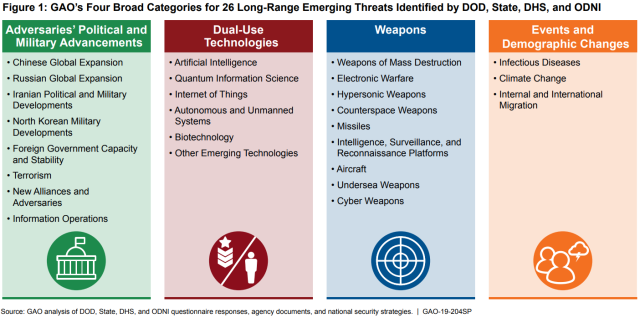Emerging Threats to the United States
The United States faces many threats to our political, economic, military, and social systems that could hurt national security.
Federal agencies, including the Departments of Defense, State, and Homeland Security, as well as the Office of the Director of National Intelligence, identified a number of these long-range, emerging threats, which fall under 4 broad categories:
- Foreign adversaries’ political and military developments
- Dual-use technologies
- New weapons
- Climate events and demographic changes
Today’s WatchBlog explores.
Global expansion by foreign adversaries
Our adversaries are developing new political and military strategies to advance their interests, which may or may not be intended to harm the United States.

For instance:
- China is marshalling its diplomatic, economic, and military resources to facilitate its rise as a regional and global power—and it could challenge U.S. access to air, space, cyberspace, and maritime domains. China’s use of cyberspace and electronic warfare could also hurt various U.S. systems and operations.
- Russia is increasing its capacity to challenge the United States in multiple domains, including attempting to launch computer-based directed energy attacks (i.e. electronic warfare) against U.S. military assets. Russia is also expanding its military and political presence in key locations around the world.
Dual-use technologies
Dual-use technologies are those that are developed by governments or the private sector for benign purposes, but which could also be used to inflict harm. In an adversary’s hands, these technologies may pose a risk to the United States.
For example:
- Quantum communications—the ability to transmit information encoded in quantum states of light and matter—could enable adversaries to develop secure communications that U.S. personnel would not be able to intercept or decrypt because the quantum states cannot be replicated. It may also allow adversaries to decrypt information, which could help them target U.S. personnel and military operations.
- Biotechnology can be used to alter genes or create DNA to modify plants, animals, and humans. Such technology could enhance the performance of military personnel or be used to create new chemical and biological weapons.
New weapons
Advances in weapons may also be used by our adversaries to inflict harm upon the United States.
For instance:
- China and Russia are pursuing hypersonic weapons –a class of weapons that can exceed five times the speed of sound—because their speed, altitude, and maneuverability may defeat most missile defense systems. These weapons can also be used to improve long-range conventional and nuclear strike capabilities, and they have no existing countermeasures.

- Russia has made significant advancements in submarine technology and tactics to escape detection by U.S. forces. Additionally, China is developing underwater acoustic systems—which could provide greater undersea situational awareness—that could coordinate swarm attacks (the use of large quantities of simple and expendable assets to overwhelm opponents).
Climate and demographic changes
Weather events and demographic changes don’t have an adversary behind them, but they can still harm the United States.
For example:
- Governments in megacities (i.e., over 10 million people) across Asia, Latin America, and Africa may not have the capacity to provide adequate resources and infrastructure in response to natural or man-made disasters. Consequently, mass migration events could occur and threaten regional stability, undermine governments, and strain U.S. military and civilian responses.
- Extreme weather events—such as hurricanes and megadroughts—could intensify and affect food security, energy resources, and the health care sector. For instance, diminishing permafrost could expand habitats for pathogens that cause disease. Additionally, the loss of Arctic sea ice could open previously closed sea routes, potentially increasing Russian and Chinese access to the region and challenging the U.S.’s freedom of navigation.
Watch our video showing the impact of floods on a DOD Installation.
To learn more about these and other emerging threats, check out our full report.
- Comments on GAO’s WatchBlog? Contact blog@gao.gov.
GAO Contacts
Related Products

GAO's mission is to provide Congress with fact-based, nonpartisan information that can help improve federal government performance and ensure accountability for the benefit of the American people. GAO launched its WatchBlog in January, 2014, as part of its continuing effort to reach its audiences—Congress and the American people—where they are currently looking for information.
The blog format allows GAO to provide a little more context about its work than it can offer on its other social media platforms. Posts will tie GAO work to current events and the news; show how GAO’s work is affecting agencies or legislation; highlight reports, testimonies, and issue areas where GAO does work; and provide information about GAO itself, among other things.
Please send any feedback on GAO's WatchBlog to blog@gao.gov.






